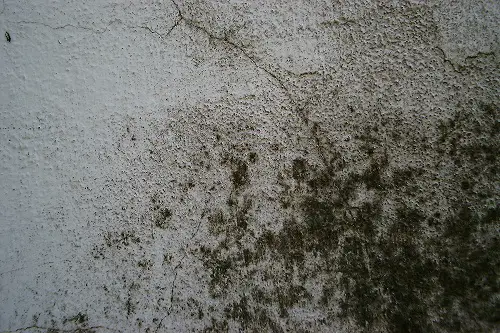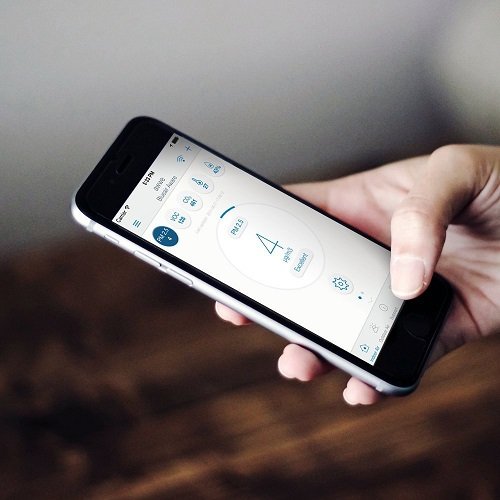Air quality monitors can’t detect mold spores or give specific details about mold such as the number of spores or the type of mold. However, they can help detect mold and mildew by detecting conditions that lead to mold growth such as high temperature and humidity. The Airthings Wave mini, for example, is specifically designed to detect mold-growing conditions based on ASHRAE standards.

Most air quality monitors are not suitable for mold detection since they cannot detect mold spores in the air. They normally measure a range of air quality factors such as volatile organic compounds (VOCs) and airborne particles. Some air quality monitors can also measure temperature and humidity, which are indicators of mold growth. However, temperature and humidity data do not directly help find if and where mold is growing.
For mold to grow, temperature and humidity have to be relatively high for an extended period of time. Additionally, mold needs a food source such as wood, cloth, or food scraps. Another factor that influences mold growth is how often the growth spot gets cleaned.
There are a few ways to determine if you might have mold growth, including the air quality monitor Wave Mini.

What is the best air quality monitor for mold detection?
There are no air quality monitors that can detect mold spores in the air. However, any air quality monitor that measures temperature and humidity can help determine mold growth risk.
However, you will need to be able to interpret the temperature and humidity data. Below, I give some tips on how to interpret this data.
The Airthings Wave Mini includes a feature that does this interpretation for you.
How the Airthings Wave Mini operates
The Airthings Wave Mini compares your indoor air conditions over a longer period of time with industry standards from ASHRAE (The American Society of Heating, Refrigerating and Air-Conditioning Engineers). With this, it can determine your mold risk based on factors such as temperature and humidity measured over time.
For example, it calculates how fast molds can grow based on the data from your air. Combined with the knowledge and standards from ASHRAE, an indication is given for the risk of mold growth.
At the end of this article, I go into why I recommend the monitors from Airthings.
Check out the Wave Mini in this video:
How to use any air quality monitor to detect mold
For the following steps to give an indication of mold growth, you will need an air quality monitor that measures temperature and humidity. Additionally, the device needs to be able to display the results of several days in data or a graph for you to interpret.
Following the next steps will give you a good indication if and where mold is growing.
- determine the most likely places for mold growth (see below for what these are) and place the air quality monitor in this area for an extended period of time. (For example, the Airthings Wave Mini takes at least 2 days to make a first mold risk report)
- measure the air temperature and humidity levels of this area for several days at least. If you measure longer, you will have a better idea of the risk of mold growth.
- interpret the data:
- are the humidity levels consistently below 70%? then you most likely do not have a mold issue.
- mold grows best at temperatures between 77 (25C) and 86 F (30C). However, they can grow at near-freezing temperatures as anyone who forgot to clean their fridge for some time can tell.
Following these steps only gives an indication of the possibility of mold growth in the area where the air quality monitor was placed. If you have multiple areas that you suspect could have mold. Follow these steps for each of those places.

What are the most likely places for mold growth?
Molds require certain conditions such as temperature and moisture to grow. These conditions are more easily found in the following areas of the house.
The areas with the highest chance of mold are:
- the windowsill
- behind or underneath furniture is rarely moved
- on external walls near the floor
- small closed areas such as the closet where the fuse box is situated (the electricity and water connections of the house)
- the fridge (+ underneath and behind it)
- the basement
- the bathroom
- the kitchen
- the garage
- the crawl space
- the attic
What are the best conditions for molds to grow?
The following list contains the best conditions for molds to grow. If you have any of these conditions in a certain area, make sure you check for molds, clean them out and take measures to prevent mold growth.
The preferred conditions for molds to grow are:
- an average relative humidity above 70% or the presence of water or damp
- the most likely mold-growth temperature is between 77 (25C) and 86 F (30C)
- the presence of oxygen (it is extremely unlikely for this not to occur)
- the presence of a food source. Molds can grow on any organic matter such as wood. But even dust, which contains small amounts of skin cells and hairs, is enough for molds to grow. It is almost impossible to prevent the presence of a suitable food source as mold needs very little.
- Poor cleaning habits. Often and thorough cleaning helps prevent the presence of food sources for molds and removes the first establishments of mold growth. However, cleaning is not a foolproof measure since cleaning agent residue can function as a food source for molds.
Why we can’t create conditions to prevent mold growth
Unfortunately, we simply cannot create living conditions in our house that make sure molds will not grow. Molds prefer similar temperatures to humans and there will always be food sources available for molds. Oxygen deprivation is also not a feasible option as molds require only low amounts of oxygen.
Our best options are cleaning and moisture control. Cleaning regularly in areas that are prone to mold growth such as the kitchen and bathroom removes the first establishments of molds. On top of that, moisture and air humidity control help prevent the best conditions for mold growth.
One last option you can try is to use mold-preventing paints or primers. I have used some myself on an old moldy bathroom wall in our previous rental apartment. You can find anti-mold primer here on amazon.com.
What can be done to minimize mold growth?
If you are struggling with high relative humidity in certain areas of the house, a dehumidifier is a great option. A dehumidifier actively removes moisture from the air. With a dehumidifier, you can make sure the relative humidity never reaches 70% or higher (the ideal humidity for molds). You can find all kinds of dehumidifiers on amazon.com. Or, even better, you can do a small quiz to find the most suitable dehumidifier on sylvane.com.
Another option is to increase ventilation. This will refresh the air in the room often and hereby remove excess moisture from the air. You could also run your air conditioner to achieve the same result. However, when the outdoor air has high humidity due to rainfall or the season (autumn and winter), ventilating works less well.
Why I recommend the Airthings Wave Mini
Airthings makes some of the best-rated air quality monitors available and their Wave Mini is specifically designed to help detect mold.
I recommend the monitors from Airthings since they have a good range of products that score excellent on my criteria. These criteria include specific compounds that should be measured, as well as, readability and battery life. For more information, I recommend reading my article: What to look for in an air quality monitor (essential measurements and features).
Discount code for Airthings store
Readers of this website can get a 10% discount on the Airthings Wave Mini and other Airthings appliances. With the following coupon code, you can access the discount store: discount.airthings.com. Here, you will get access and 10% off when entering this coupon code: 665381-10OFF.
A one-time mold test kit
If you just want to test for mold once or twice, you can use a DIY mold test kit instead of an air quality monitor. These test kits include a lab analysis that can directly tell if and what type of mold you have. Some test kits also offer to consult with an expert.
However, these test kits require you to take a sample of a surface you expect might have mold. This means that you can easily miss a spot where mold actually does grow. Additionally, keep in mind that you will need to pay for the shipping costs of sending the test to the lab. Therefore, the costs can go up and you might want to consider purchasing an air quality monitor instead.
If you plan on using a test kit, I recommend testing your HVAC system internally, in this way, you might detect mold or spores that are in your air.
You can find these test kits on amazon.com via this link.


